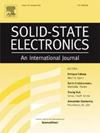用于改进硅自旋量子比特静电控制的叠加双触点栅极堆
IF 1.4
4区 物理与天体物理
Q3 ENGINEERING, ELECTRICAL & ELECTRONIC
引用次数: 0
摘要
基于门定义量子点的自旋量子比特需要沿着有源层进行严格的静电控制。大规模多量子位器件必须能够单独控制相邻量子点对的隧道耦合,以执行双量子位门和自旋读出。在这里,我们提出了广泛使用的TiN/多晶硅栅极堆栈的一个小修改,在保留栅极间距的同时为隧道耦合提供额外所需的控制旋钮。我们定义了隧道控制的相关指标,执行了与玩具模型耦合的3D器件模拟以优化器件布局,并证明了这样的门堆栈代表了大规模一维自旋量子比特阵列的可扩展构建块。本文章由计算机程序翻译,如有差异,请以英文原文为准。
Superimposed two-contact gate stacks for an improved electrostatic control of Si spin qubits
Spin qubits based on gate-defined quantum dots require a tight electrostatic control all along the active layer. Large-scale multi-qubit devices must enable an individual control over the tunnel coupling of neighbor QD pairs to perform two-qubit gates and spin readout. Here we propose a small modification of the widely used TiN/Polysilicon gate stack that offers an extra required control knob for the tunnel coupling while preserving the gate pitch. We define the relevant metrics for the tunnel control, perform 3D device simulations coupled to a toy model to optimize the device layout, and demonstrate that such a gate stack represents a scalable building block for large-scale one-dimensional spin qubit arrays.
求助全文
通过发布文献求助,成功后即可免费获取论文全文。
去求助
来源期刊

Solid-state Electronics
物理-工程:电子与电气
CiteScore
3.00
自引率
5.90%
发文量
212
审稿时长
3 months
期刊介绍:
It is the aim of this journal to bring together in one publication outstanding papers reporting new and original work in the following areas: (1) applications of solid-state physics and technology to electronics and optoelectronics, including theory and device design; (2) optical, electrical, morphological characterization techniques and parameter extraction of devices; (3) fabrication of semiconductor devices, and also device-related materials growth, measurement and evaluation; (4) the physics and modeling of submicron and nanoscale microelectronic and optoelectronic devices, including processing, measurement, and performance evaluation; (5) applications of numerical methods to the modeling and simulation of solid-state devices and processes; and (6) nanoscale electronic and optoelectronic devices, photovoltaics, sensors, and MEMS based on semiconductor and alternative electronic materials; (7) synthesis and electrooptical properties of materials for novel devices.
 求助内容:
求助内容: 应助结果提醒方式:
应助结果提醒方式:


